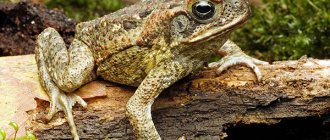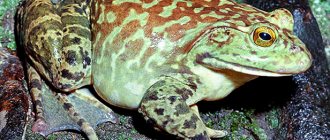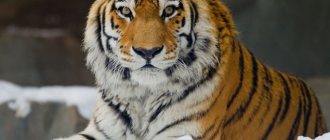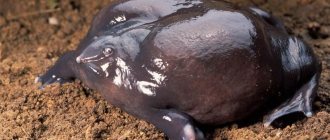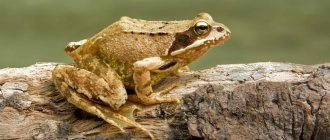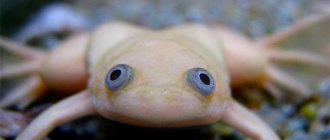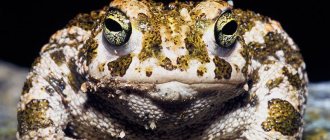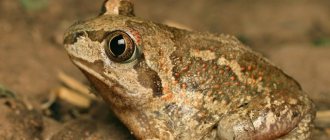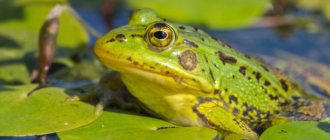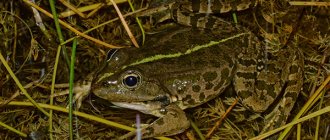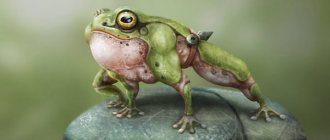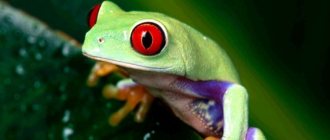Frogs are amphibians (amphibians), not reptiles! The word "amphibian" comes from the Greek word amphibio, which means "to live a double life." Amphibians begin their lives in the water before moving to land as they get older.
There are about 7,000 species of amphibians on Earth, the most common of which are frogs (90% of the total number of species). The first frogs date back to the Jurassic period more than 140 million years ago. They are found all over the world, with the exception of Antarctica. Frogs live in freshwater bodies and prefer lakes, swamps, slow rivers and ponds. They cannot live in salt water such as in oceans and seas.
Internal structure
Adult amphibians are predators, feeding on various insects and other invertebrate animals; some aquatic amphibians catch small vertebrates.
Digestive system
The digestive system begins with a large oropharyngeal cavity, at the bottom of which the tongue is attached at the anterior end. When catching prey, the tongue is thrown out of the mouth, and the prey sticks to it. Streams of salivary glands open into the oropharyngeal cavity. Their secretion moistens the cavity and food, making it easier to swallow prey. On the upper jaw there are small conical teeth that serve only to hold prey. Food moistened with saliva enters the esophagus and then into the stomach. The glandular cells of the stomach walls secrete the enzyme pepsin, which is active in an acidic environment (hydrochloric acid is also released in the stomach).
Partially digested food moves to the duodenum, into which the bile duct of the liver flows. Pancreatic secretions also flow into the bile duct. The duodenum quietly passes into the small intestine, where nutrients are absorbed. Undigested food remains enter the wide rectum and are expelled through the cloaca.
Respiratory system
The frog breathes through its lungs and through its skin. On the walls of the paired sac-like lungs there is an extensive network of blood vessels. When the frog opens its nostrils and lowers the bottom of the oropharyngeal cavity, air enters the latter.
Then the nostrils close with valves, the bottom of the oropharyngeal cavity rises, and air passes into the lungs. Exhalation occurs due to the action of the abdominal muscles and the collapse of the pulmonary walls.
Circulatory system
The heart of adult amphibians has three chambers - two atria and one ventricle. An arterial cone with a longitudinal spiral valve inside extends from the ventricle, which distributes arterial and mixed blood into different vessels. The right atrium receives venous blood from internal organs and arterial blood from the skin, i.e. mixed blood gathers here. The left atrium receives arterial blood from the lungs. Both atria contract simultaneously and blood flows from them into the ventricle. Thanks to the longitudinal valve in the arterial cone, venous blood flows to the lungs and skin, mixed blood flows to all organs and parts of the body except the head, and arterial blood flows to the brain and other organs of the head.
Amphibians have two circuits of blood circulation, but they are not completely separated due to a single ventricle. In a large circle, blood flows from the ventricle to all organs, and from them through the veins it returns to the right atrium. In the pulmonary circle, blood flows from the ventricle to the lungs and skin, and from there, enriched with oxygen, it returns to the left atrium.
Excretory system
The excretory system is represented by two kidneys located on the sides of the sacral vertebra. The kidneys contain glomeruli, in which harmful breakdown products and some valuable substances are filtered from the blood. During the flow through the renal tubules, valuable compounds are reabsorbed, and urine flows through two ureters into the cloaca and from there into the bladder. After filling the bladder, the muscles of its walls contract, urine is discharged into the cloaca and thrown out.
Nervous system
The brain has the same sections as those of fish. The forebrain is more developed, divided into two hemispheres.
The cerebellum is small, which is explained by a sedentary lifestyle and monotony of movements.
In the eyes of adult amphibians, movable eyelids (upper and lower) and a nictitating membrane are developed; they protect the cornea from drying out and contamination.
Metabolism
Reptile class
Reptiles are a large group of terrestrial vertebrates. These include lizards, snakes, crocodiles and turtles. During the Carboniferous period, Reptiles flourished and dominated. The planet witnessed the heyday of the era of dinosaurs, which are typical representatives of this class.
Compared to the Amphibia, this is a more progressive group. In their life cycle there is no connection with water, breathing becomes completely pulmonary. The skin is dry and covered with horny scales. One of the primitive features remains the absence of a constant body temperature.
The class Reptiles is divided into the following orders:
- detachment Beakheads;
- order Scaly;
- squad Crocodiles;
- Turtle squad.
There are no questions with representatives of the Crocodiles and Turtles groups. The Scaly group includes lizards and snakes, while the Beaked group has only one representative - the tuateria.
Sense organs
The sense organs are more complex than those of fish; they provide orientation for amphibians in water and on land. Adult amphibians living in water have developed lateral line organs; they are scattered on the surface of the skin, especially numerous on the head. The epidermal layer of the skin contains temperature, pain and tactile receptors. The olfactory organ is represented by paired olfactory sacs, which open outward with paired external nostrils, and into the oropharyngeal cavity with internal nostrils. Some of the walls of the olfactory sacs are lined with olfactory epithelium. The olfactory organs work only in the air; in water, the external nostrils are closed. The olfactory organs of amphibians and higher chordates are part of the respiratory tract.
The cornea of the eye is convex, the lens has the shape of a biconvex lens. The retina contains rods and cones. Many amphibians have developed color vision.
In the hearing organs, in addition to the inner ear, the middle ear is developed. It contains a device that amplifies sound vibrations. The external opening of the middle ear cavity is covered with an elastic eardrum. The cavity contains the auditory ossicle. The middle ear cavity is connected by a narrow canal to the oral cavity.
Comparative characteristics of representatives
Amphibians and Reptiles have both a number of common features and features that are characteristic only of one class. For ease of comparison, these features are summarized in a table.
| Signs | Class Amphibians or Amphibians | Class Reptiles or Reptiles |
| 1. Skin | Smooth and covered in mucus | Dry, covered with horny scales |
| 2. Breathing | Mainly cutaneous, pulmonary | Pulmonary |
| 3. Availability of water in the development cycle | Eat | No |
| 4. Body temperature | No constant body temperature, cold-blooded | No constant body temperature, cold-blooded |
| 5. Habitats | Near bodies of water or shady, damp places (forest) | On land, in warm and humid places |
| 6. Fertilization | External | Internal |
Reproduction
The ovaries and testes of amphibians and fish are similar. External fertilization occurs in water. Gonads are paired. Paired oviducts flow into the cloaca, seminiferous tubules into the ureters. Frogs reproduce in the spring during their third year of life.
The male attaches himself to the female’s back, tightly clasping her with his front paws. The thickenings on the inner toes help to clasp the paws so as not to lose sight of the female for several days. During this time, the female releases up to 3,000 eggs, and the male immediately waters them with milk. As a result, almost all the eggs are fertilized, and none of the amphibians have to hurl millions of them, as is often the case with fish, so the eggs can be larger, which means there are more reserves in each.
The eggs are covered with a mucous membrane, which swells greatly in water. The shells, like lenses, collect the rays of the sun and heat the eggs by several degrees, accelerating their development.
What does a frog eat?
The lurking frog is a cunning hunter, whose prey is moving individuals: spiders, insects, worms, slugs and fish fry. Having decided on the future food moving in its field of vision, the frog in the water lets the latter closer and throws out a wide sticky tongue, to which the insect sticks. The frog is able to swallow large prey, placing it in its mouth using its forelimbs. There are known cases when swallows drinking water in flight became their victims. What does a frog eat? By running, flying, crawling past her, that is, moving; a stationary object simply will not arouse interest in a tailless amphibian.
The family of tailless amphibians is most often found on the banks of reservoirs in the warm season. The animal’s movements are so expressive and sharp that it immediately becomes clear where the expressions “swims like a frog” or “jumps like a frog” came from. When making a jump, the frog sharply straightens its legs; the force generated by such a push throws the amphibian forward and upward. Landing occurs on short front legs. The frog swims just as sharply, pushing off the water with its hind legs, between the toes of which there are membranes. If we return once again to clarifying the question “is a frog an animal or an insect?”, the answer is clear: an animal!
Nutrition
Insectivorous frogs
They are predators, happily eating small invertebrates. Particularly large ones do not disdain more impressive prey; some species of animal frogs even mercilessly devour their own relatives.
To hunt their victims, frogs use a sticky and long tongue, which they deftly catch midges and other living creatures in mid-flight. Among the frog species there are also omnivores that happily eat fruit.
Frogs bring enough benefits to humans, destroying and eating many harmful ones, and. Therefore, many owners of vegetable gardens and household plots treat such helpers with great sympathy and create all the conditions for them to breed and live.
Frogs are eaten, making them extremely original dishes, which are delicacies and are used for gourmet tables.
Can a frog fly?
In the process of evolution, this amphibian learned to fly, escaping from enemies in this way. Flying specimens, which can even change their flight path (sometimes reaching 12 meters), are characterized by spreading long, webbed fingers. Frogs, with human help, are capable of setting world records.
So, in a long jump competition organized especially for them, held in 1977 in South Africa, the frog nicknamed Sandtji jumped 10.3 meters!
Population and species status
Research shows a significant decline in the total number of frogs . More than a third of all known species are currently under threat of extinction. The causes of this plight are most often habitat destruction, noticeable climate change and alien predators.
Particularly destructive and dangerous for the frog population are infectious diseases represented by chytridiomycosis and ranavirus. Among other things, amphibians in general and some frogs in particular have an increased sensitivity to severe environmental pollution, which is due to too permeable skin and the characteristics of their life cycle.
Amphibian habitats
Like reptiles, amphibians prefer to live in warm regions. Frogs are usually found in damp places near bodies of water. But you can see them in meadows and forests, especially after heavy rain. Some species thrive even in deserts. For example, the Australian toad. She has adapted very well to survive long droughts.
Under such conditions, other types of toads would certainly die quickly. But she learned to accumulate vital moisture in subcutaneous pockets during the rainy season. In addition, during this period it reproduces, laying eggs in puddles. It only takes one month for tadpoles to fully metamorphose. The Australian toad, in extreme conditions for its species, not only found a way to reproduce, but also successfully find food for itself.
Is the skin of frogs poisonous?
By the way, the skin of poisonous frogs in ancient times served as the main component in the manufacture of poison for arrows; one individual was enough to lubricate 500 units. The toxicity of frogs can be judged by their bright, downright garish coloring. Thus, the poison of the dart frog - an inhabitant of South America - even in an amount of 2 milligrams can kill a person.
Coloring also serves to camouflage the animal; The leader in this area is considered to be the mossy frog, which almost completely merges with the environment, even its eyes are barely visible against the background of moss.
This particular type of frog is very popular among exotic lovers who want to keep it as a pet. The beautiful coloration of this representative of the tropics is valued accordingly: the cost of one individual, which can perfectly climb rocks and tall trees, reaches $75.
Fish snakes
Fish snakes are another large family of legless snakes, including about 40 species. All of them live exclusively in Asia. The animals are widespread in the Malay Archipelago, Thailand, India, China and Malaysia. Among them there is an endemic with a very narrow range - the Ceylon fish snake, which lives only in the southern part of the island of the same name.
The body of such an individual grows to a maximum of 50 centimeters and is covered with small scales. They are distinguished from other representatives of caecilians by the presence of a short but noticeable tail, as well as adductor muscles in the jaw.
Fish snakes live near the banks of rivers and other bodies of water. After hatching from eggs, their larvae develop for a long time in water. It is noteworthy that adult individuals live only on land and can die if they fall into a body of water.
Character and lifestyle
Frogs are able to move perfectly on land, as well as make huge jumps, climb the crowns of tall trees and dig underground holes. Some species are characterized by the ability not only to swim perfectly, but also to run, walk, quickly climb trees, and even easily glide from a height.
One of the very interesting features of frogs is the absorption of oxygen through the skin. This process is quite successfully carried out on land or in water, due to which the animal belongs to the category of amphibians. However, European grass frogs, which are very widely known in our country, approach water bodies only during the period of active reproduction.
An interesting fact is that frogs need lungs in order to make rather loud and peculiar sounds called croaking . Sound bubbles and resonators help the amphibian produce the widest range of sounds, which is most often used to attract the opposite sex during the breeding season.
Periodically, adult frogs shed their skin, which is not an organ necessary for the life of an amphibian animal, and then eat it in anticipation of the growth of new skin. According to their lifestyle, all true frogs are sedentary loners, prone to short-term migration over short distances only during the breeding season. Species that live in temperate zones hibernate with the onset of winter.
How do frogs communicate with each other?
Frogs communicate with each other in a range inaccessible to the human ear through the use of ultrasounds that are beyond human audibility. This can be explained by the noisy habitat of amphibians, in which low frequencies familiar to humans are difficult to distinguish. This feature in frogs is also facilitated by the unusual location of the hearing organ; The eardrums are located behind the eyes, inside a special cavity. According to scientists, this arrangement of ears allows frogs to overcome the water noise inherent in their habitat. The most vocal frogs can cover a radius of several kilometers. From the cry of a bullfrog, heard for the first time and associated with the roar of a huge terrible beast, you can run away without looking back.
What are they?
Like other amphibians, all legless amphibians are vertebrates. They lead a predominantly underground lifestyle, so finding them is quite difficult. Science knows about 200 species of caecilians - this is much less than other orders of amphibians.
Legless animals already existed in the Jurassic period, that is, about 200 million years ago. The earliest representatives belonged to the genus Eocaecilia. They lived in the US state of Arizona. They had short limbs and well-developed eye sockets and tails.
Modern representatives of the order of legless amphibians have no legs, and their vision is very poor - animals perceive only light and darkness, without distinguishing between surrounding objects. They do not have a tail as such, or it is weakly expressed. Outwardly, they are very similar to worms, but are more complex creatures. Caecilians are superior to their primitive “doubles” in at least an advanced nervous system and a developed brain. Some individuals even have developed parental behavior.
Family of true caecilians
This family is one of the most extensive in the entire order. Many of its representatives live in Central and South America. These include the olive caecilian, which lives on the Pacific coast, the Linnaeus caecilian, common in Brazil, Suriname, Peru, Ecuador, Colombia, as well as the Marcus caecilian, which is endemic to Bolivia.
The family includes from 42 to 96 legless species, depending on the classification. The largest species of true caecilians and the largest representative of the order in the world is Thompson's caecilian. It reaches a length of 120 centimeters.
Ringed caecilians
These legless creatures live exclusively in South America, in areas east of the Andes. They are found in Brazil, Argentina, Venezuela, Suriname, Paraguay, Peru and Ecuador.
These creatures are not famous for their large sizes and reach a length of only 40-50 centimeters. The body of annelid caecilians is noticeably divided by transverse rings. Their larvae are equipped with 44 small teeth, with which they eat the top layer of the mother's skin. After eating everything in a matter of minutes, they wait about three days for the skin to grow back. The phenomenon is called “maternal dermatophagy” and it lasts until the babies grow up and are able to feed on their own.
